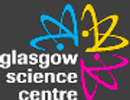Real science at GSC
What it's all about
On this site you will find topical science news stories written by teachers and scientists.
Interactive games, activities and educational resources help young people and teachers to engage with the news and the science behind it.
The resources consist of:
A Science Trail around Glasgow Science Centre directly related to each news story.
A Solving the Puzzle page that connects the science in the trail with the science in the story.
Hyperlinks, pop-up definitions and progressive questions to guide a reader through the news story.
Suggested classroom discussion topics
Relevant learning outcomes from the new science curriculum.
How it works
The aim is to make science accessible and interesting to young people by combining up-to-the-minute research news with Glasgow Science Centre resources and the interactivity of the Web.
The latest story, adapted to be readable by children aged 11 upwards, appears on the Science news page. Hyperlinks are included to webpages that elucidate, educate, entertain or shed further light on topics that appear in the story. As far as possible these contain animations, illustrations, video, photographs or audio – multimedia to make for a more interactive reader experience.
Words can be a major barrier to anyone trying to read about science. Scientific terms often have meanings different to their everyday meanings. And writers about science, even when they don't use specifically scientific terms, often reach for long words that are hard to understand.
So the readability of the science news stories is enhance through pupil-friendly meanings provided in a little box that appears when the cursor is placed over a word. This is called a mouseover.
The news story is followed by a set of comprehension questions that guide students to engage with steadily more difficult ideas. Internal links are provided, especially for the earlier questions, pointing the reader to the place in the text where an answer can be found. The browser Back button will return the reader to the questions.
All this is designed to be used by students without much in the way of teacher intervention. The set of activities on the Discussion page are intended to be more teacher-led, and contain suggestions for engaging students with the science in the story through group discussions, research or preparing presentations. Cooperative learning is recommended to structure these activities. ("Cooperative learning is group work, but group work is not necessarily cooperative learning.")
Suggested activities on the discussion page often contain links to relevant resources from some of the growing number of excellent websites that provide free educational science activities.
So let's take a look at the science trail for the latest Real Science story.

